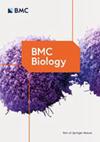缺氧和 Foxn1 改变了真皮成纤维细胞的蛋白质组特征,从而使 Foxn1-/- 小鼠的无疤痕伤口愈合转变为有疤痕皮肤伤口愈合
IF 4.4
1区 生物学
Q1 BIOLOGY
引用次数: 0
摘要
Foxn1-/- 缺陷小鼠是哺乳动物中罕见的皮肤伤口再生愈合模型。在受伤的皮肤中,转录因子 Foxn1 与缺氧调控因子相互作用,影响了皮肤的再上皮化、上皮-间质转化(EMT)和真皮白色脂肪组织(dWAT)的重建,因此是调节疤痕形成/恢复性愈合的一个因子。在此,我们假设 Foxn1 和 Hif-1α 之间的转录串扰控制着皮肤伤口愈合从无疤痕(再生性)到有疤痕(修复性)的转换。为了验证这一假设,我们研究了(i)缺氧/缺氧和 Foxn1 信号对 Foxn1-/-(再生性)真皮成纤维细胞(DFs)蛋白质组特征的影响,然后(ii)探讨了通过慢病毒(LV)递送载体引入 Hif-1α 或 Foxn1/Hif-1α 对再生性 Foxn1-/- 小鼠受伤皮肤的影响,尤其关注了愈合的重塑阶段。我们发现,缺氧条件和Foxn1刺激改变了Foxn1-/-DFs的蛋白质组。缺氧条件会上调 DF 蛋白谱,尤其是那些与细胞外基质(ECM)组成相关的蛋白:纤溶酶原激活物抑制剂-1(Pai-1)、Sdc4、Plod2、Plod1、Lox、Loxl2、Itga2、Vldlr、Ftl1、Vegfa、Hmox1、Fth1 和 F3。我们发现,缺氧条件会刺激再生 Foxn1-/- DF 中的 Pai-1,但只有在缺氧和 Foxn1 刺激的情况下,DF 才会将 Pai-1 释放到培养基中。我们还发现,从 Foxn1+/+ 小鼠(修复型/疤痕形成型)分离出来的 DFs 中的 Pai-1 蛋白水平高于从 Foxn1-/-(再生型/无疤痕)小鼠分离出来的 DFs 中的 Pai-1 蛋白水平。然后,我们证明了通过慢病毒注射将 Foxn1 和 Hif-1α 导入再生 Foxn1-/- 小鼠的损伤皮肤中,可通过增加损伤皮肤面积、减少透明质酸沉积和 III 型胶原与 I 型胶原的比例来激活修复性/瘢痕形成性愈合。我们还发现,在 Foxn1-/- 小鼠创伤皮肤中注射 LV-Foxn1 + LV-Hif-1α 对 Pai-1 蛋白水平有刺激作用。本研究数据强调了缺氧和 Foxn1 对再生 Foxn1-/- DF 蛋白特征和功能的影响,并证明在再生 Foxn1-/- 小鼠的损伤皮肤中引入 Foxn1 和 Hif-1α 能激活修复/瘢痕形成愈合。本文章由计算机程序翻译,如有差异,请以英文原文为准。
Hypoxia and Foxn1 alter the proteomic signature of dermal fibroblasts to redirect scarless wound healing to scar-forming skin wound healing in Foxn1−/− mice
Foxn1−/− deficient mice are a rare model of regenerative skin wound healing among mammals. In wounded skin, the transcription factor Foxn1 interacting with hypoxia-regulated factors affects re-epithelialization, epithelial-mesenchymal transition (EMT) and dermal white adipose tissue (dWAT) reestablishment and is thus a factor regulating scar-forming/reparative healing. Here, we hypothesized that transcriptional crosstalk between Foxn1 and Hif-1α controls the switch from scarless (regenerative) to scar-present (reparative) skin wound healing. To verify this hypothesis, we examined (i) the effect of hypoxia/normoxia and Foxn1 signalling on the proteomic signature of Foxn1−/− (regenerative) dermal fibroblasts (DFs) and then (ii) explored the effect of Hif-1α or Foxn1/Hif-1α introduced by a lentiviral (LV) delivery vector to injured skin of regenerative Foxn1−/− mice with particular attention to the remodelling phase of healing. We showed that hypoxic conditions and Foxn1 stimulation modified the proteome of Foxn1−/− DFs. Hypoxic conditions upregulated DF protein profiles, particularly those related to extracellular matrix (ECM) composition: plasminogen activator inhibitor-1 (Pai-1), Sdc4, Plod2, Plod1, Lox, Loxl2, Itga2, Vldlr, Ftl1, Vegfa, Hmox1, Fth1, and F3. We found that Pai-1 was stimulated by hypoxic conditions in regenerative Foxn1−/− DFs but was released by DFs to the culture media exclusively upon hypoxia and Foxn1 stimulation. We also found higher levels of Pai-1 protein in DFs isolated from Foxn1+/+ mice (reparative/scar-forming) than in DFs isolated from Foxn1−/− (regenerative/scarless) mice and triggered by injury increase in Foxn1 and Pai-1 protein in the skin of mice with active Foxn1 (Foxn1+/+ mice). Then, we demonstrated that the introduction of Foxn1 and Hif-1α via lentiviral injection into the wounded skin of regenerative Foxn1−/− mice activates reparative/scar-forming healing by increasing the wounded skin area and decreasing hyaluronic acid deposition and the collagen type III to I ratio. We also identified a stimulatory effect of LV-Foxn1 + LV-Hif-1α injection in the wounded skin of Foxn1−/− mice on Pai-1 protein levels. The present data highlight the effect of hypoxia and Foxn1 on the protein profile and functionality of regenerative Foxn1−/− DFs and demonstrate that the introduction of Foxn1 and Hif-1α into the wounded skin of regenerative Foxn1−/− mice activates reparative/scar-forming healing.
求助全文
通过发布文献求助,成功后即可免费获取论文全文。
去求助
来源期刊

BMC Biology
生物-生物学
CiteScore
7.80
自引率
1.90%
发文量
260
审稿时长
3 months
期刊介绍:
BMC Biology is a broad scope journal covering all areas of biology. Our content includes research articles, new methods and tools. BMC Biology also publishes reviews, Q&A, and commentaries.
 求助内容:
求助内容: 应助结果提醒方式:
应助结果提醒方式:


